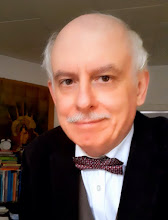The same goes for art. The nazis annexed high culture in an attempt to lend credibility to one of the most destructive and evil regimes the world has ever seen, but that does not mean that any culture thus victimized, is tainted by association. People who think that 20C figurative art and tonal music is part of an attempt to support insanity and evil, are blaming the victim, and thus unintentionally side with the forces which wanted to destroy the realm of true artistic achievement and humanist expression.
Music and visual art after WW I show a field of the greatest diversity, ranging from traditionalism to an avantgardism that wanted to reject everything from the past since that was the cradle of the senseless insanity of the war. An ironic or cynical expression of that insanity, meant as critique and warning, became part of the artistic field; deformation, ugliness, emptiness, frivolity and nihilism - as understandable reaction to war trauma - became artistic extensions of the creative palette, as well as a surface of coldness and emotional suppression.
In 'Avantgarde, Trauma, Spiritualität' the German musicologist Wolfgang-Andreas Schultz explores this territory with the instrument of depth psychology and the history of ideas, an impressive endeavor which has recently been extended and crowned by his 'Die Heilung des Verlorenen Ichs' which offers an entirely credible and enlightening analysis of the subject, plus perspectives for future developments.
The painful conclusion of all this is, that the notorious exhibition of 'Entartete Kunst' that the nazis organised in 1937, although a primitive and ignorant thing, touched a point of truth and reality: that deformation and ugliness had entered the field of artistic expression. Only, the real reasons were completely missed, and the painful effect of so much modern art (and music) merely described as a process of erosion of something that had been worthwhile and noble. Given the grim circumstances of the Weimar Republic and the devastating effects of the Great Depression, the general longing for something better in life was thus cleverly manipulated. And the art which was offered as an alternative to 'degenerate deformation', a rude and kitschy form of classicism, besmeared the reality of any classical art from the past that had survived the times. The annexation by the nazis of 'classical art and music' as the expression of the 'purity of the German race' does not mean, that Rembrandt and Beethoven are fascistoid, nor that modernism is superior to surviving classicism because of it having been banned by dangerous idiots. The aureole of moral superiority surrounding post-1945 modernism and its forerunners from the interbellum is an unintentional present from the nazis, not an inherent characteristic of the art form, and the association with the Holocaust (after 1945 modernism as the only morally acceptable option) an entirely dishonest annexation of a moral catastrophe to enhance the legitimacy of the 'avantgarde'.
The association of new figurative art and new tonal (serious) music in our own time with rightwing politics belongs to the same category as the above-described miserable misunderstandings. It takes some courage to disentangle the reality of artistic expression from the tentacles of demented degeneration of evil politics, and to recognize dehumanizing tendencies in modernism itself, characteristics which are closer to totalitarian ideas than its advocates are mostly aware of. The irony of the 'Entartete Kunst' exhibition is that the degeneration that it wanted to reveal, was at the heart of the movement that wanted to reject it and replace it by imitation kitsch. The anti-humanism of much modernist art, also in its earlier manifestations in the twenties, is related to the anti-humanism of fascism and communism. This trait comes clearly to the fore in its post-1945 avantgardism with its ideologies, exclusions, fatwas, condemnations and directives - entirely independent from any evil political regime: the artists themselves were quite capable of organising their own mental concentration camp without such support. Recognizing the evil behind its manifestations is thus a complex and rather painful business, but unpicking the entanglements of history is the only way in which the reality of authentic artistic expression can be found again and understood.

Profoundly astute observations!
ReplyDelete